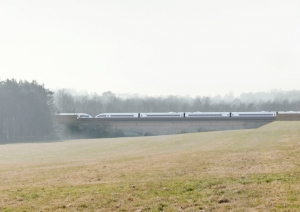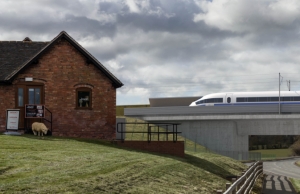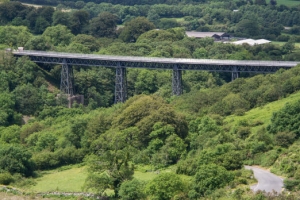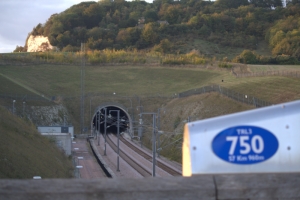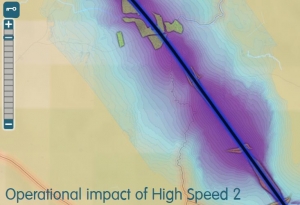The Government has today revealed its long awaited decision to proceed with phase 2b of HS2, which would connect Manchester and Leeds with the Midlands. The consultation document says there is currently no funding for junctions to link HS2 better with the existing rail network.
Ralph Smyth, Head of Infrastructure and Legal at the Campaign to Protect Rural England, comments:
'HS2 will simply fail to live up to its promises if it is not integrated with wider upgrades to the rail network. Communities in the North and Midlands have been crying out for better rail links in rural areas – not just the cities HS2 is proposed to connect. Parkway stations plonked in the Green Belt, like that proposed a mile away from Manchester Airport, would create gridlock rather than faster journeys.
'With the Government expecting to miss targets to cut carbon emissions from transport by 50% when the first phase of HS2 is due to open [1], much more work is needed to ensure phase two entices people out of cars and planes. Heathrow’s plans to subsidise new domestic air routes as part of plans for a third runway would seriously damage the financial and environmental case for these proposals.
'Although the route chosen for phase two would be less harmful than phase one, there needs to be at least as much ambition to make it fit in with the north’s countryside as the south’s, if landscape and tranquillity are to be safeguarded. Some high viaducts may be inevitable in hillier areas but let’s make sure they can be exemplary designs we can cherish, not soulless, standardised concrete.'
[1] The Environmental Audit Committee’s recent report Sustainability in the Department for Transport notes in its Recommendation 7 that ‘The Committee on Climate Change advice on the lowest-cost pathway to the UK’s 2050 emissions reduction target included an interim 2025 decarbonisation objective, which the transport sector is projected to miss by almost 50%. Transport is now the largest emitting sector; emissions have increased for the past two years running. We recommend the Department set out in the Government’s forthcoming carbon reduction plan how it intends to deal with this shortfall in decarbonisation. (Paragraph 32)’
An edited version of Shaun Spiers' speech to the Local Government Association conference on 6 July 2016:
"CPRE celebrates its 90th anniversary this year and throughout our history we have engaged actively with major infrastructure projects. The years since 1926 have seen the growth of aviation, the development of motorways, the spread of electricity to all parts of the country, and much else.
CPRE has not been saying ‘no’ throughout these years. In the words of our founder, Sir Patrick Abercombie, our aim has been to “achieve a balance between existing features – natural and historic – and new growth”. CPRE’s first President, Lord Crawford, a former Minister of Transport, said: “We have got to have new roads and bridges, new suburbs, new villages and perhaps new towns. Our desire is that they shall be comely, and shall conform to modern requirements without injuring the ancient beauty of the land.” And our first statement of aims and objects declared: “It is part of [CPRE’s] policy to promote suitable and harmonious development.”
What are the prospects now for “suitable and harmonious development”? And how easy will it be to get consent for the new infrastructure the nation needs? CPRE is calling for a new approach to infrastructure planning, one where national and local aspirations go hand in hand.
- One that engages and really listens to local people and local authorities – nothing is more alienating than a consultation where the decision has already been made
- One where national infrastructure helps make rather than break places it passes by, and
- One which recognises that infrastructure is not all about big schemes
The National Infrastructure Commission offers a great opportunity to help deliver our vision. Already we have had good dialogue. We welcome the Government’s decision in May to include quality of life within the Commission’s scope. There still needs to be a substantial shift in emphasis, however, particularly on full engagement. And that’s the area I’ll focus on first.
1 Engaging with people
Whoever you’re speaking with about planning and barriers to infrastructure, the same refrain is repeated. The problem is public mistrust. And the problem is getting worse. It is not enough to draw on experts to establish the facts. We saw in the referendum campaign how facts were disputed and expertise discounted. In that campaign, the Treasury failed to persuade the British people that leaving the European Union would be a serious economic mistake. That was partly because the economic consequences of Brexit seemed diffuse while the perceived consequences of membership – a lack of school places, for instance, or poor housing conditions – were immediate.
So it is with infrastructure. The benefits for the nation may seem clear, but the nation is an abstraction. The dis-benefits for those living near the infrastructure tend to be clear and immediate. So the National Infrastructure Commission has an uphill task, however well something similar works in Singapore. With experts out of favour, there needs to be another piece in the jigsaw. I am not saying experts and evidence do not have a role. But we need to build consensus to build infrastructure. And for that we need a new way of doing things.
Rather than the Far East we should look closer to home – to France. The French have developed one of the finest processes for public debate on infrastructure projects. First developed in the 1980s after public outrage over a high speed railway proposed through vineyards, they have continuously improved it. Here, we are still using Victorian procedures to give consent to 21st century railways. Over two dozen consultations on HS2 and the battles are still running. France’s Public Debate Commission has representatives from user groups, the courts, industry, environmental NGOs, courts and local politicians, not least those from rural areas.
Crucially this commission makes suggestions rather than decisions. And of the dozens projects it has considered, a third have been fundamentally changed. In some cases, such as the planned route of Charles De Gaulle Express air rail link, the objectors’ proposal became what was approved. Scheme promoters welcome its feedback, as it means they get things right early on. We believe a similar Commission should be set up here through the Bill. It could carry out debates on the top three most controversial issues identified in the 2017 consultation on the National Infrastructure Assessment vision, allowing the NIC to focus on what it does best, building the evidence base. It could also streamline and supercharge pre-application consultation on Nationally Significant Infrastructure Projects, taking responsibility for this from developers.
Putting all your infrastructure eggs in an expert basket is not sensible post Brexit. The NIC has made an impressive start and may yet establish its independence from the Treasury in the way that other bodies such as the Climate Change Committee and the Monetary Policy Committee have. But the Committee’s Chair is appointed by the Chancellor and its Chief Executive by the Treasury. The outgoing Chancellor – for all his admirable qualities, and his commitment to improving the nation’s infrastructure – has had a tin ear when it comes to hearing concerns about how and where stuff is built. He has a disdainful view of the planning system, regarding it merely as a barrier to getting things done, rather than the means by which we can build well and make better places.
And this worldview is not unique to this Chancellor. It is the Treasury View. J.M. Keynes identified it in 1939 when, in an essay for CPRE, he railed against the “sub-human denizens of the Treasury… nourished on dry husks”. I could never use such disrespectful language. But consent is vital, and something akin to the French Public Debate Commission would help achieve it, complementing the expertise of the National Infrastructure Commission.
2 Making not breaking places
Although we can hark back to Victorian stations and signature bridges, much of our ordinary infrastructure is frankly awful: pylons running across some of our finest landscapes; cut and paste concrete viaducts; ugly, noisy, light polluting roads. For far too long it has been acceptable simply to consider ‘minimising harm’ to the environment. Mitigation has been the name of the game. With so much being invested - rightly - in updating our infrastructure, we need to do better. What we build today will say so much about us tomorrow. And for many years to come.
So we need to take care how we build. We should aspire, in Abercrombie’s words, to create ‘new forms of beauty’. Poor decisions can ruin places. But good design need not cost more, even leaving aside the economic value of beautiful places, and the cost of ugly places which no one wants to look at, still less live near. Research published earlier this year by RICS shows that better placemaking can command a premium of as much as 50% on the value of houses.
How should the route strategies that Highways England is preparing take account of opportunities to make better places. The removal of the A14 viaduct in Huntingdon or the tunnelling of the A3 under the Devil’s Punchbowl are well known. But there are other, smaller potential opportunities, not least in rural areas. This debate should not simply be about how infrastructure looks, but about how it can fundamentally change perceptions of places.
Other countries are far more ambitious than we are. The city of Hamburg is grassing over the autobahn that passes through it. This is not just to reduce air and noise pollution but to create new space for houses and allotments. In response to the Government’s roads reform agenda, CPRE made the case for a ‘roads retrofit’. We are pleased that the Road Investment Strategy includes a £500 million Environment Fund to help deliver this. We hope that Highways England will shortly announce plans to deliver green bridges over its network, to restore landscapes and connectivity for wildlife and communities. The Netherlands has over 60; we only have half a dozen.
Architects firm LDA Design have given the example of a Swansea tidal lagoon. By adding landscaping and networks of cycle paths, it could transform run-down areas of the city, on top of generating power. In the Victorian era, London’s Embankment addressed flooding, sewage, the tube and road travel. Achieving more than one thing from an infrastructure project makes even more sense now, in our densely country. Too often projects have narrow objectives set early on. The best megaprojects ‘flex’ through their development.
3 Fair split between local and national
There will always be competing tensions between investing in large and small scale infrastructure. But once we start thinking about infrastructure as networks - rather than discrete, individual schemes - the importance of the local becomes clear. When it comes to rolling out broadband, leaving out the last few miles is a false economy. There is little benefit in having a superfast fibre cable to your town if you cannot get it in your home.
Likewise with energy, we will need to improve the local distribution of energy as we get more decentralised, ‘smart’ power. The emphasis should be on small scale local improvements. In fact investing at the local level can reduce or remove the need for infrastructure in the first place. Improving energy efficiency is at least as important as building power stations.
On transport, CPRE has been highlighting the gulf in investment between strategic roads and local transport. Even if you could build your way out of congestion - and the evidence is pretty clear that you can’t - we will never have enough money to build bigger local roads to feed into bigger national ones. And the impact on places would be devastating. The proposal for a National Road Fund, announced last year by the Chancellor, has been dropped from the forthcoming Neighbourhood Planning and Infrastructure Bill. It would have given all Vehicle Excise Duty to Highways England, who run just 2% of our roads. Drivers who rarely venture out onto the motorway but face a bumpy ride on potholed local roads will be hoping the idea has been dropped for good.
There is a need for adequate funding of the Cycling and Walking Investment Strategy. While London has over £10 a head, rural areas are getting less than £1.40 on cycling and walking. Of course cycling never mind walking is not an option for longer journeys. But Department for Transport research shows that congestion on long distance routes is usually where these roads also have to cater for short distance traffic around towns. This investment is sorely needed to give people travel choices.
Our railways keep on getting busier. That’s a great thing. But in some places, without more network capacity, hard choices are being made. Better services between cities or protecting stops at rural stations? Value for Money calculations tend to prioritise incremental improvements for those travelling between cities over a decent service for those living in between. But the impact on leaving country towns with a just a skeleton service can be devastating to their continued viability.
We should not forget the benefits of construction either, such as for local business and skills. The Government gives the examples of Crossrail and the Olympics as infrastructure projects that have driven supply chain investment and skills, whether for large companies or Small and Medium Enterprises. We all remember the enchanting scenes of farmyard animals running riot round the green and pleasant land at the Olympics opening ceremony. But both of these projects are predominantly urban projects. If interurban projects like HS2 are to deliver benefits to the supply chains in areas they pass through, a different approach will be needed. CPRE welcomed the £30million HS2 Environment and Business Funds, which we had been calling for since 2011. It is a start, a small start. More needs to be done through procurement and promotion to help smaller rural businesses benefit, such as from landscaping and environmental mitigation works.
In all these examples, change is happening quickly. There are real risks that some people and some areas will not share the benefits. We need better evidence about network effects for new forms of infrastructure and better debates about how the costs and benefits should be distributed across society.
We need and better informed debates about how the costs and benefits from infrastructure investment and management should be distributed across society. Key to this is recognising that financial formulae cannot tell the whole story.
Conclusion
Today I have set out CPRE’s approach to infrastructure – let’s call it a vision. A vision that engages all sections of society in decision-making. Those who would benefit directly from new infrastructure as well those who it would simply pass through. We need what could be called ‘Place Responsive Infrastructure’. We are not a country with vast areas of emptiness, but one that is densely populated country. And finally, we need a call for a new balance between investment in local and national needs, and proper consideration of when new infrastructure might not be the right option.
I hope we can get this right. Buildings can enhance the landscape. Few lovers of the countryside would now wish unbuilt the great Victorian viaducts, country houses, dry stone walls or lovely villages. But where we have to build, we should try hard, in the words of John Buchan, launching CPRE Oxfordshire in 1931, to “replace old beauty with new beauty and not with new ugliness”. And if we can do that, we will find it much easier to get public agreement to development.
Responding to the Government publication Broad Options for upgraded and High Speed Railways between the north of England and Scotland, Ralph Smyth, Head of Infrastructure and Legal at CPRE, said:
"With capacity and resilience as important as speed, we welcome this major study on the way forward for our railways between the north of England and Scotland.
Reducing travel times between Scotland and London is critical, if we are going to shift people from air to rail. Although it may be the headline, it should not however be the only consideration. Because of the priority given to intercity and freight trains on the mainline, many rural communities in areas like Cumbria have limited or no local rail services. Investment has to deliver for people in the countryside, if a national case is to be made. So it’s only right that a range of different ideas has been put forward, rather than presenting a new high speed line as a single, inevitable ‘option’.
The West and East Coast Mainlines pass by one World Heritage Site, three National Parks, four Areas of Outstanding Natural Beauty and five Green Belts. It will be vital for any detailed proposals to protect these cherished landscapes. The willingness to consider a range of speeds, rather than insisting on a world beating 400km/h, is a sensible start."
CPRE argues that re-opening line between Plymouth and Exeter would revitalise rural communities and provide resilience against climate change
The Government’s new transport strategy must revitalise or build diversionary routes on the rail network to mitigate major disruption caused by floods, says CPRE.
The countryside charity today (Tuesday) claims that the Government's draft plan for transport infrastructure fails to consider the threat to existing transport networks from flooding, and believe it to be illegal.
CPRE is calling for the Department for Transport to revise its draft National Networks Policy Statement so that the rail network can be made more resilient to extreme weather, you can add your voice and Send a letter today
Under Section 10(3) of the Planning Act 2008 the Government is required to consider the need to adapt to more extreme weather caused by climate change. But while the plan requires new infrastructure to be flood proof, it completely fails to consider the need to upgrade existing infrastructure, in particular the rail network, which is increasingly at risk of flooding, coastal erosion or land slips.
Ralph Smyth, Senior Transport Campaigner and barrister for CPRE said:
‘Why isn’t Government seeking to improve infrastructure that already exists before beginning a massive road building programme that is set to tear up the countryside?’
‘According to the latest figures from the Environment Agency, England's railways are at twice the risk of flooding as major roads. But when floods or coastal erosion cut railways off, as we have recently seen, the disruption caused has much more impact because there’s often no alternative route. With rail travel more popular than ever the loss and disruption to businesses, as well as massive inconvenience to people when services are cancelled, is enormous.'
Ralph Smyth concludes:
‘The Government says its draft transport policy considers the nation's transport needs for the next 30 years but only three months after publication, it already doesn’t stand up. We need better and more rural rail routes because when the main lines go down it causes major disruption.’
CPRE warned today (Nov, 26) that the consultation timescale for the HS2 hybrid bill is likely to breach international law. Responding to the announcement that the consultation on the environmental impact of HS2 will end as early as 24 January 2014, Ralph Smyth, barrister and Senior Transport Campaigner for the Campaign to Protect Rural England, says:
‘The Government has chosen the minimum length of time allowed for its consultation on the biggest ever environmental impact assessment in UK history. A 56 day formal consultation period for 50,000 pages of documents means you would need to read 1,000 pages a day just to know what is proposed. To add insult to injury this period includes the Christmas and New Year holidays, when Parliament has 23 days off.
‘The UN Aarhus Convention requires “sufficient time...for the public to prepare and participate effectively during the environmental decision-making”. Clearly more time is needed for such a large consultation so CPRE will be formally raising the UK’s non-compliance with the appropriate UN bodies.’
HS2 Ltd has told CPRE that it will take up to 20 working days to make open data from the consultation on the formal Environmental Statement available. This means the charity will not be able until early January to update its interactive mapping of HS2’s impacts at www.hs2maps.com. This has proved much more accessible to people affected than the technical engineering drawings published by HS2 Ltd. Smyth continued:
‘While CPRE accepts the case for a new north-south railway, the Government has not yet fully made the case for its particular scheme and the impacts on the countryside. With such limited time to assess all this new evidence, we will have to be cautious. Such a reckless timetable is likely to fan the flames of opposition as well as make it impractical for the public to suggest sensible changes to improve the proposals.’
Ahead of the publication of the High Speed Rail (London - West Midlands) Bill on Monday 25 November 2013, the Campaign to Protect Rural England is concerned that the Government appears to be back-tracking on commitments to secure any environmental gains from HS2.
To maximise the positive impact of HS2 the Government must shift travel from road to rail, regenerate brownfield sites in northern cities, reduce carbon emissions, and offset landscape impacts, for instance by burying pylons along the route.
Background
CPRE believes the case for a new north-south railway has been made, but we are yet to be convinced by the Government's plans for HS2. Some of the main questions for CPRE are:
1. Are there any significant changes to the route to protect the countryside?
Recent changes to the route, such as increased tunnelling, have either been in urban areas or to facilitate major new developments. No major changes to the route of phase 1 are expected. There may be additional mitigation announced in some places, for example to reduce the impact on the habitats of protected species that have been discovered as part of environmental surveys.
2. Will HS2's environmental case have improved?
HS2 must rebalance our transport system away from roads and the economy away from the south east to the north. Yet the Government's deregulation of the planning system and plans for a major return to road-building have weakened the potential for HS2 to lead to environmental benefits, whether its carbon savings or reducing pressure on the countryside.
3. Is HS2 aiming for world beating or just bog standard design?
Other countries have aimed for iconic design in their new railways but we are concerned that photomontages of HS2 have shown ugly, concrete viaducts striding brutishly across the countryside. At CPRE's annual lecture in November 2012, the Secretary of State announced he would set up a design panel for HS2 but nothing has been heard publicly since. The High Speed Rail (Preparation) Act 2013 permits the letting of design contracts so CPRE is concerned that if the panel is not set up at the start of 2014, it will be too late to embed exemplary design in the project.
4. Has the cost of rejected route alterations been provided?
HS2 Ltd has faced criticism for rejecting proposals to reduce HS2's impact as too costly, without stating how much more expensive alternatives would be compared to its own proposals. CPRE believes greater transparency is essential if the process of deciding on mitigation is to be credible, particularly with the communities directly affected.
More details about our position and our research are available at www.cpre.org.uk/hs2
In advance of a vote in the House of Commons on Thursday on the High Speed Rail (Preparation) Bill, the Government is due to publish a revised case for High Speed 2 (HS2). In accordance with Treasury guidance, the new business case should include:
- a ‘strategic case’, making the case for change and the rationale for investment; and
- an ‘economic case’, setting out all the costs and benefits, including those that cannot be monetised, such as impact on precious landscapes.
Ralph Smyth, Senior Transport Campaigner for the Campaign to Protect Rural England, says:
‘It’s time to ask how well HS2 fits with a wider, sustainable vision for the country. Trying to reduce all the different costs and benefits of this huge transport scheme into a single figure simply isn’t possible. We should move away from trying to value HS2 in terms of how many pounds are returned from each pound of investment.
‘The revised strategic case offers the Department for Transport a chance to show it has listened to the arguments put forward and is prepared to make changes. But the Government’s timetable for HS2 means that they are working at such a breakneck speed that we are worried that the result will only be more tinkering.’
CPRE believes the strategic case has already been made for a new north-south railway because of the lack of existing capacity to run more trains. In terms of the economic case, we believe there are problems with the current proposals for HS2, as well as with the way the Government is trying to assess it.
CPRE will be considering the revised case against the following issues in particular:
1. Will HS2 still rely on a Benefit Cost Ratio (BCR)?
The Department for Transport (DfT) first tried to justify HS2, saying it would produce a return of £2.60 for every pound spent, although this figure has since reduced. Other countries simply do not think it credible to try to reduce all the economic, social and environmental costs into a single number. The DfT’s system of appraisal was originally designed to compare small road schemes and CPRE believes it cannot usefully assess the case for HS2, a whole new transport network.
2. Will forecasts still assume no change to land use?
While the Chancellor has justified HS2 saying it would change the ‘economic geography’ of the country, the current method of transport appraisal assumes no changes to land use. This seems odd. Regeneration of urban areas has been a key objective for high speed rail in other countries but it is not counted as an economic benefit here.
3. How would capacity be measured?
Perhaps the most bitter argument over HS2 is whether there are alternative ways to provide extra seats on trains. CPRE has highlighted that providing extra seats on long-distance trains is of little use if there is no capacity to run local trains that stop at your station.
4. How would impacts on existing train services be considered?
Even if the UK’s rail system was not privatised, it would be impossible to predict how timetables might turn out 15 years or more into the future. While plans for HS2 stretch to 2033, Network Rail has plans for the rest of the rail network until only 2019. CPRE believes that more confidence is needed about long-term plans for the rest of the rail network, particularly for rural areas that have seen little direct benefit in recent rail investment.
5. Will any new environmental case be made for HS2?
Until Deputy Prime Minister Nick Clegg suggested that HS2 would help protect London’s Green Belt, the possibility of making any environmental case for HS2 seemed to have been forgotten. CPRE believes the case for HS2 could be improved if there was greater emphasis on moving development pressure from greenfield sites in the south east to promoting the regeneration of brownfield sites in northern cities.
6. Will environmental impacts be valued?
The DfT has tried to value impacts on the landscape by adding up the cost of land that would be used. CPRE has criticised this as being like valuing paintings using the cost of paint. Environmental impacts cannot be easily monetised and better ways are needed to explain the possible environmental benefits and costs of HS2.
7. Has the impact on passenger numbers of DfT's controversial new road-building programme been taken into account?
In July, the DfT published Action for Roads, which proposed the biggest roads programme since the 1970s. Increasing road capacity would increase competition between road and rail. Although this would reduce the growth in rail travel, the DfT admitted to CPRE in August that its modelling was ‘ongoing and incomplete’.
8. Will any ways to cut the cost of HS2 be considered?
With increasing pressure on HS2’s budget, ways to reduce the cost may be considered. CPRE has called for the stations proposed in the Green Belt to be scrapped, highlighting HS2 Ltd’s prediction that the Manchester Interchange station would generate just 300 jobs but would cost £300m.
